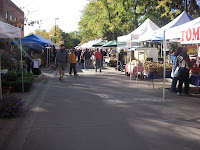Monday, December 21, 2009
Mid Winter Festival
Sunday, December 20, 2009
Farmville

Saturday, December 19, 2009
Frontera, Inspection, and a Waste of Good Food
Saturday, December 5, 2009
Petri Pork: One More Step to Ruining Our Food
Thursday, December 3, 2009
Sweet Potatoes and Yams
Factor | Sweetpotato | Yam | |
1. | Scientific Name | Ipomoea batatas | Dioscorea Species |
2. | Plant family | Morningglory (Convolvulaceae) | Yam (Dioscoreaceae) |
3. | Plant group | Dicotyledon | Monocotyledon |
4. | Chromosome number | 2n=90 (hexaploid) | 2n=20 |
5. | Flower character | Monoecious | Dioecious |
6. | Origin | Tropical America (Peru, Ecuador) | West Africa, Asia |
7. | Historical beginning | Prehistoric | 50,000 BC |
8. | Edible storage organ | Storage root | Tuber |
9. | Number/plant | 4 to 10 | 1 to 5 |
10. | Appearance | Smooth, with thin skin | Rough, scaly |
11. | Shape | Short, blocky, tapered ends | Long, cylindrical, some with "toes" |
12. | Dry matter | 22 to 28% | 20 to 35% |
13. | Mouth feel | Moist* | Dry |
14. | Taste | Sweet* | Starchy |
15. | Beta carotene (Vit. A) | High (orange vars.)* | Very low |
16. | Propagation | Transplants/vine cuttings | Tuber pieces |
17. | Growing season | 90 to 150 days (120= Jewel) | 180 to 360 days |
18. | Maturity | None | At senescence |
19. | Storage | (Cured at 80 to 86oF) 55 to 60oF | 54 to 61oF |
20. | Climatic requirements | Tropical and temperate | Tropical |
21. | Availability | Grown in USA | Imported from Caribbean |
Monday, November 23, 2009
Questions?
Saturday, November 21, 2009
Seed Catalog
Saturday, November 14, 2009
A Refreshing Night
If there are no upcoming screenings in your area, please contact the director to get a DVD to host a local screening in your home or community center.
You can also become a fan on Facebook (they list the upcoming screenings on there, too).
Friday, November 13, 2009
CSA News
Thursday, November 5, 2009
Sauce, Butter, and Leeks


Tuesday, October 27, 2009
Five Crows Garden Show Part One
Two Sundays ago, Naomi and I went to Five Crows home to help her build her raise beds. The raise beds were designed by yours truly with additions and modifications provided by Naomi. The construction of the garden went well and by the end of the day Five Crows had a great raised bed garden if I do say so myself.



 After connecting those four boards I was off to the garage to begin cutting out the 4 foot lengths so we could begin constructing the five checker box design.
After connecting those four boards I was off to the garage to begin cutting out the 4 foot lengths so we could begin constructing the five checker box design. Monday, October 26, 2009
The Grand Opening of Growing Home's Wood Street Farm
Sunday, October 25, 2009
Allium sativum




A Boulderific Farmers' Market
 Earlier this month Naomi and I went on a trip out west. Our first stop was Boulder, Colorado for her brother's wedding. While we were out there we heard quite a bit about the fabulous farmers' market that they had. The previous year we had seen Denver's, but her brother told us that nothing could beat Boulder's. So we went to have our own look.
Earlier this month Naomi and I went on a trip out west. Our first stop was Boulder, Colorado for her brother's wedding. While we were out there we heard quite a bit about the fabulous farmers' market that they had. The previous year we had seen Denver's, but her brother told us that nothing could beat Boulder's. So we went to have our own look.







Wednesday, September 23, 2009
I'm Back! With Quite a Bit to Say
Thursday, August 27, 2009
Its the Start of Junkfood Season
Thursday, August 20, 2009
Top Chef Masters
Saturday, August 15, 2009
Summer, Food, and Friendship
The End of Blossom End Rot
Wednesday, August 12, 2009
The Manors of Somerset-Lytes Cary
 Lytes Cary was the second manor house that we went to. The house itself was not as big nor the gardens, however the gardens were packed with beauty and inspiration. Lytes Cary was the home of herbalist Henry Lyte. He is the author of A niewe Herball and an antiquarian book, The Light of Brityane. Henry Lyte transformed the gardens around his home to reflect his profession as an herbalist. The garden was established in the 14th century and was thoughtfully improved throughout the intervening centuries.
Lytes Cary was the second manor house that we went to. The house itself was not as big nor the gardens, however the gardens were packed with beauty and inspiration. Lytes Cary was the home of herbalist Henry Lyte. He is the author of A niewe Herball and an antiquarian book, The Light of Brityane. Henry Lyte transformed the gardens around his home to reflect his profession as an herbalist. The garden was established in the 14th century and was thoughtfully improved throughout the intervening centuries.  The Apostles Garden: These shrubs were shaped in a very interesting way and create an interesting area for a good game of chase or tag.
The Apostles Garden: These shrubs were shaped in a very interesting way and create an interesting area for a good game of chase or tag. 
 The Long Walk-These hedges were kept in immaculate shape and definitely gave you the feeling you were going somewhere important.
The Long Walk-These hedges were kept in immaculate shape and definitely gave you the feeling you were going somewhere important. The Pond Garden at the end of the Long Walk.
The Pond Garden at the end of the Long Walk. Another garden...there was quite a bit packed into the grounds of this manor as you can tell. It was much smaller than Stourhead.
Another garden...there was quite a bit packed into the grounds of this manor as you can tell. It was much smaller than Stourhead.Monday, August 10, 2009
The Manors of Somerset-Stourhead



 Now this is one big tree to hug. This tree had the leaves of a tulip popular, however I have never seen one this big before.
Now this is one big tree to hug. This tree had the leaves of a tulip popular, however I have never seen one this big before.  The temple to Apollo (This picture is from the National Trust website the temple was being restored during our trip there)
The temple to Apollo (This picture is from the National Trust website the temple was being restored during our trip there)
































